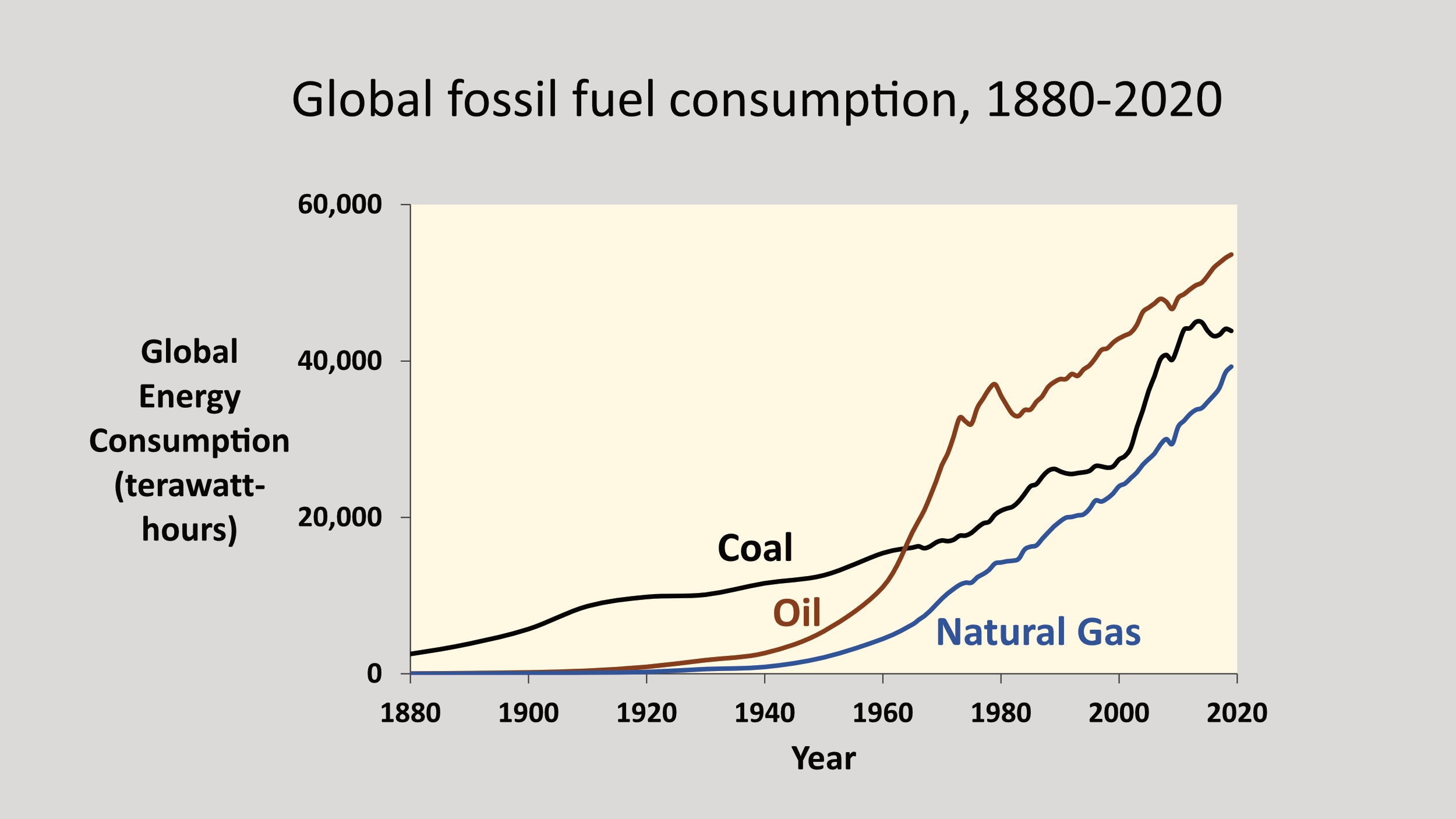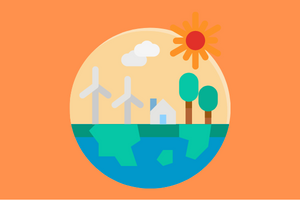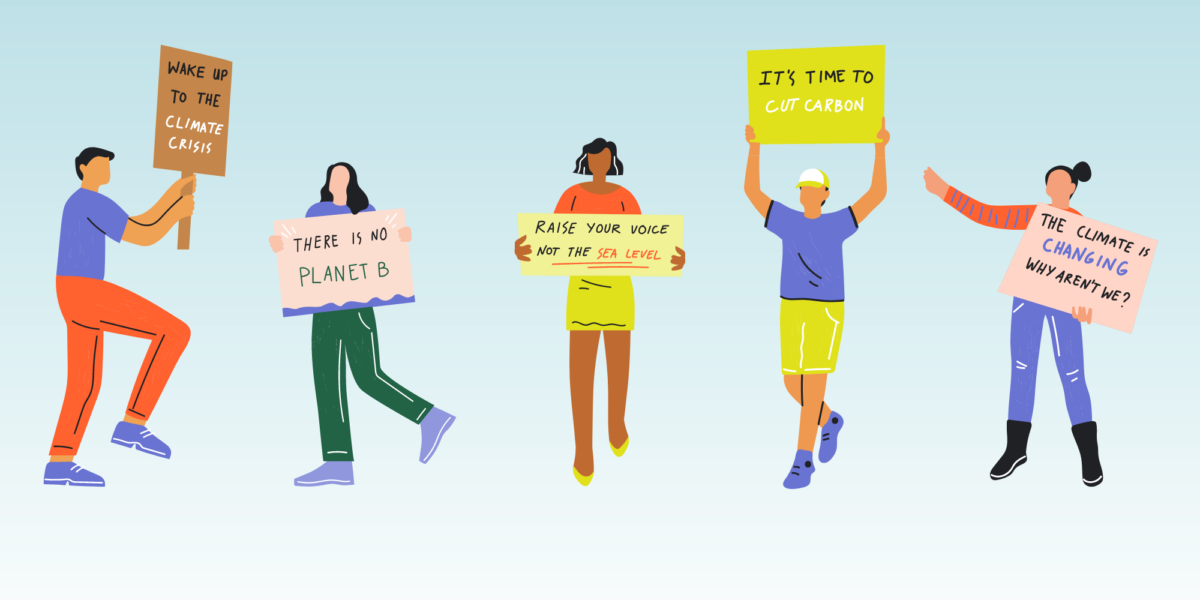Chapter Contents
Obstacles to Addressing Climate Change
- Controversial Issues and Complex Systems
- Creating Meaningful Dialogue
- Factors That Influence How We Think
- How do People Change Their Minds?
- How Can We Envision New Systems?
- Resources
Image above by Ingrid Zabel for PRI's Earth@Home project (CC BY-NC-SA 4.0 license) with images from Canva
“The first principle is that you must not fool yourself and you are the easiest
person to fool."
“A new scientific truth does not triumph by convincing its opponents and
making them see the light, but rather because its opponents eventually die,
and a new generation grows up that is familiar with it.”
A third or more of Americans reject the scientific consensus that human-induced climate change is real and a serious threat to our economy and environment, in spite of abundantly clear evidence to the contrary. [Yale Climate Opinion Maps] Some people in leadership positions believe, or behave as if they believe, anthropogenic climate change is a hoax, confounding the problem. The question of whether climate change is real has become so politically polarizing that in some areas of the US it can be uncomfortable to discuss the subject in the classroom. How do we broach such a controversial topic with our students, and in fact how do we help create a generation of students more comfortable having meaningful dialogues than those of our current adult generation?
Responses to sociopolitically controversial topics, both those involving science (such as climate change, energy extraction, and evolution), and others such as the nature of K-16 education itself, have some patterns in common. These commonalities provide an opportunity to create some general rules of thumb for approaches in education to addressing controversial issues (see table below). The primary goal of this chapter is to uncover the shared roots of challenges to public acceptance of certain well-evidenced findings, to seek both deeper understandings of each problem and empathy for those with whom we disagree, in order to be more effective educators.
Part of the challenge in all controversial issues is that (1), the academic topics themselves (for example, the climate system and climate change) are generally interdisciplinary and complex, and (2), key findings from research on those topics have implications for equally complex societal systems (such as economic, energy, and political systems). It is common to say that a system such as the world energy system is “broken,” because the system delivers problematic outcomes. But another perspective is that many systems still work more-or-less as originally intended – when developed decades or centuries ago – but yield numerous and substantial unintended consequences. Alternatively, they may “work” in a different sense in that they function as self-replicating systems, continuing to operate not because they satisfy their original goals, but rather they persist because they suit the system in some other way.
For example, the structure of the economy is not grounded in research on climate change. The economy took its basic form long before climate science became robust. Energy choices were made based on availability of known energy sources and the price per unit of energy long before the economics of environmental and health consequences were known. Some impacts of energy use became (relatively) quickly known at local scales, such as decline of air quality from coal burning in cities such as London and Pittsburgh, but awareness of global impacts by those making political and economic decisions remained a century away. Likewise, development of today’s global coordination of extraction and distribution of fossil fuels did not take into account the eventual enormous cumulative environmental impacts and associated costs. The energy system to a large extent achieves its fundamental goals of making energy widely available and profiting those employed in the industry, and in this sense it doesn’t need to be “fixed” so much as it needs to be re-envisioned to fulfill a broader set of goals. By analogy, jet planes did not originate from the improvement or repair of canal boats. Likewise, wind farms are not repaired coal power plants. If the wider ramifications of the interactions of human-made and natural systems had been understood from the start, some decisions about the construction of human-made systems may have been different and the world might look very different today.

In isolation and in hindsight, the idea of burning hundreds of millions of years of fossil fuels in just a few hundred years seems insane. After all, the chemical properties of carbon dioxide are well known, and evidence is strong that atmospheric carbon dioxide concentration has strongly influenced the temperature of other planets (e.g., Venus) and past Earth climates. And we can quantify the amount of organic carbon sequestered in sedimentary rocks, of which a substantial fraction has been burned, well enough to know that it is significant relative to the amount of carbon in the atmosphere as carbon dioxide. It would, based on these observations, be quite surprising if the Earth’s climate were not changing after burning so much organic matter, which had taken about a million times longer to accumulate over geologic time than the time it has taken to burn it.
But the infrastructure that makes possible heating our homes, transporting us, and creating large amounts of electricity was well-formed before and while these scientific understandings were developing. The lives of billions of people are now partially dependent on these big human constructs—the infrastructure has grown to such a size and familiarity, that it has become nearly impossible to build new systems while the old ones are still running.
Table: Rules of Thumb for Teaching Controversial Issues

1. Be nice (but there are limits).
Treating those who disagree as either idiots or evil people is unlikely to convince them that you’re correct.
- Know your audience. “Nice” has different meanings with different audiences.
- For the most part, people aren’t lying. They largely believe what they say. Default to the expectation that the people you are interacting with believe what they are saying unless you have good evidence to the contrary.
- Advocacy may deepen convictions more than understanding. Evangelism turns on people who agree with you and turns off many who don’t. Being certain and being right aren’t the same thing, and they aren’t all that closely related. Put more faith in people and institutions that are pretty sure than those that are certain.
- Don’t let the bastards get you down. Working on nurturing public understanding of controversial issues will make people angry, and angry people say and do nasty things. Have a support system you can turn to.

2. Complexify the seemingly simple.
As educators (and like journalists and politicians), we are driven to simplify the seemingly complex. It’s often important, but we do it too often. The world is complex.
- Move from debate to discussion. There are often ways to reframe away from false dichotomies.
- Controversial issues are always interdisciplinary. Pay attention to the tools and strategies of the most centrally related disciplines.
- Don’t forget the importance of the simple. While acknowledging the issue’s complexity is important, there are often simple ideas illuminated within that complexity.

3. Evidence matters, but evidence alone is not enough.
All of us hold beliefs for which ample conflicting evidence exists.
- Learn about cognitive biases (including your own) and how to communicate more effectively in light of them. Warn learners in advance to avoid biased reasoning.
- This article by Keith Stanovich has more information on decoupling prior beliefs: Stanovich, Keith E., Richard F. West, and Maggie E. Toplak. “Myside Bias, Rational Thinking, and Intelligence.” Current Directions in Psychological Science 22, no. 4 (2013): 259–264.
- State evidence clearly and directly, identifying a small number of key points. Too many different points cloud the issue.
- Mathematics matters. Scale plays a central role in many controversial issues, and understanding really large or really small numbers brings special challenges. “Social math” uses familiar examples to show volume, mass, or relative number.
- For steps for creating social math, see Appendix B in "Adding Power to Our Voices: A Framing Guide for Communicating About Injury," CDC (2008)
- Call out logical fallacies, and hold people accountable for (mis)using them. There’s a taxonomy of problematic argument types. Get to know it and put it to use.

4. Persistence matters.
Beliefs related to controversial issues are often closely tied to worldviews, and such beliefs do not change quickly or easily.
- People do change their minds on things that matter. A broad modern example is the change in acceptance of gay marriage. A more personal scale example is divorce.
- Piling on evidence can bring beliefs to a tipping point. Of course, not always.
- Reflect on big changes in your own beliefs. Chances are, it took either a long time or an immersion in the issue.
- Social media may be a better venue for this than classrooms because connections last more than a semester or a year.

5. Use one’s place in the world as a starting point
...to engage in critical inquiry of the forces working to shape that place (geology, ecology, capital flows, law, etc.).



